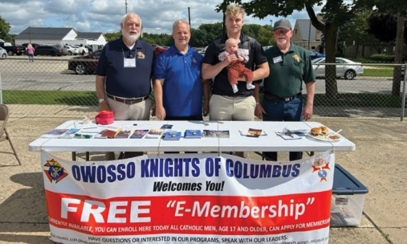Joseph “Pat” Tully, Centenarian and Knight
For a man who grew up on a farm with no running water or electricity, lost his father at age 8, and served in two theaters in World War II, Pat has the pleasant disposition of a man who knows himself and is glad to be here.
Any man of 75 would count himself blessed to have the soundness of mind and body that this remarkable man possesses. Pat has known what it is like to struggle. He was born in Sprague, Washington, and raised on a 500 acre wheat farm homesteaded there by his grandfather in 1883. In 1929, his father died from pneumonia as a complication of influenza just before the stock market crash, leaving a mortgaged farm. His mother was forced to lease the farmland for a share of crop proceeds. By using her share in a depressed market, she was able to keep the farm by paying just the interest on the debt. They also raised milk cows, chickens, and pigs for food for the family and sold the surplus for some cash.
Pat attended St. Joseph’s Academy in Sprague for 12 years, which was founded and shepherded by those marvelous pioneers, the Sisters of Providence, whose hospitals and schools were a vital resource to the early settlers of this region. Contrary to the stereotype of stern taskmasters, Pat says he never saw a sister as much as slap the hand of a student.
Pat used to later “brag” that he graduated eighth in his class. He would then notify the listener that there were but eight students in the class.
In late 1941, Pat enlisted in the Signal Corps of the U.S. Army and was sent to San Jose State University and the University of California - Davis for a total of 18 months of technical training. Pat found his calling and excelled in the science and technology of the field. He was well fed, well paid, and enjoyed a great climate. Pat calls this time a “wonderful life.”
After his training, Pat was billeted at Fort Monmouth, N.J., whose signal corps laboratories had produced the United States’ first working radar. There, he awaited transport to Europe. In April 1944, he convoyed to Liverpool via New York Harbor in the build-up to the D-Day invasion. The convoy could go no faster than the slowest ships, which were the vulnerable troop ships Pat was aboard in the protected center of the convoy. Moving at a laborious 6 knots in the notoriously rough and cold North Atlantic, it took 13 miserable days to get After the Normandy invasion, Pat was helping staff a radio relay station at Bolougne, France, on the English Channel and then moved to Paris after its liberation. Paris, and the rest of France that had been occupied, was still reeling from the occupation.
Pat’s station in Paris was the Eiffel Tower. There, he was quartered at the base and the radio relay station was near the top of the 1,000-foot tower. It had elevators, but they were inoperable in the winter, so Pat and his colleagues walked up an icy, open, steel spiral staircase to the station. One part of the handrail was broken, leaving a short but harrowing open section that was taken very cautiously, he says.
Pat’s next mission was a deployment to the far side of the Rhine River. The Remagen bridge was still a problem, so they began training for an airborne glider operation. The gliders were cloth and wood contraptions towed into the air to their destinations by C-47 planes, andwere notoriously hazardous. (They were called “the flying coffins,” even in ideal conditions.) Pat went for a training flight and his anxiety was not alleviated as he watched the pilot and co-pilot struggle to keep the craft in control. As the glider descended to the air strip, the silence was shattered as the craft’s landing gear made contact with the steel mesh laid on the ground to create the temporary landing surface. Three times the mission was scrubbed, and Germany surrendered May 5, 1945.
But the war wasn’t done with Pat. He was shipped out of Marseilles, France, to the Pacific Theater via the Panama Canal. Pat recalls that on the Atlantic side of the canal, he attended an extraordinary general confession service for the Catholic troops. At the time, they were heading toward a perilous situation: the staging areas for the invasion of Japan. During the six-week trip,, the atomic bombs were dropped and Japan surrendered before Pat’s arrival. He was diverted to New Guinea and eventually Manila, the Philippines. Manila had just been devastated by the horrific Battle of Manila, where the cornered remnant of the Japanese occupation force slaughtered around 100,000 Filipinos.
Pat eventually sailed back to the U.S., landing at San Pedro inLos Angeles before finally getting off the ship at Tacoma, Washington. He was discharged as a Staff Sergeant.
Pat went back to his mother’s house, which now not only had running water, even electricity, which had been installed in 1943 while he was away. Pat began working for AT&T in Spokane, a natural fit considering his Army training, and had a 32-year career there as a technician and manager.
In 1947, Pat married Betty Corcoran. They had six children: son Dan, daughter Chris, son John, son Jerry (deceased), and daughters Jean and Tricia, who all attended Catholic schools in Spokane. He has eight grandchildren and 13 great-grandchildren. His wife of 67 years, Betty, died in 2014.
Born a Catholic, Pat is a man of quiet but steadfast faith. During his 59 years in the Knights of Columbus, Council 683, has held virtually all the leadership roles and has never stopped being active. The council looks to him for prudential wisdom. Pat is well known for his skill at preparing prime rib and baked salmon for council dinners (before COVID-19 restrictions) and he is still helped deliver Christmas baskets of food and presents to the 28 families assisted in 2020. Long live Pat Tully!



